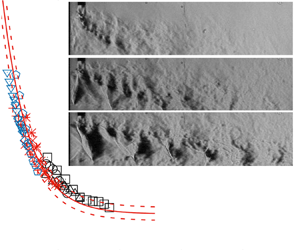No CrossRef data available.
Published online by Cambridge University Press: 05 December 2024

This work aims to perform a parametric study on a round supersonic jet with a design Mach number Md = 1.8, which is manipulated using a single steady radial minijet with a view to enhancing its mixing. Four control parameters are examined, i.e. the mass flow rate ratio Cm and diameter ratio d/D of the minijet to main jet, and exit pressure ratio Pe/Pa and fully expanded jet Mach number Mj, where Pe and Pa are the nozzle exit and atmospheric pressures, respectively. Extensive pressure and schlieren flow visualization measurements are conducted on the natural and manipulated jets. The supersonic jet core length Lc/D exhibits a strong dependence on the four control parameters. Careful scaling analysis of experimental data reveals that Lc/D = f1(Cm, d/D, Pe/Pa, Mj) may be reduced to Lc/D = f2(ξ), where f1 and f2 are different functions. The scaling factor  $\xi = J({d_i}/{D_j})/(\gamma M_j^2{P_e}/{P_a})$ is physically the penetration depth of the minijet into the main jet, where
$\xi = J({d_i}/{D_j})/(\gamma M_j^2{P_e}/{P_a})$ is physically the penetration depth of the minijet into the main jet, where  $J({d_i}/{D_j})$ is the square root of the momentum ratio of the minijet to main jet (di and Dj are the fully expanded diameters of d and D, respectively), γ is the specific heat ratio and
$J({d_i}/{D_j})$ is the square root of the momentum ratio of the minijet to main jet (di and Dj are the fully expanded diameters of d and D, respectively), γ is the specific heat ratio and  $\gamma M_j^2{P_e}/{P_a}$ is the non-dimensional exit pressure ratio. Important physical insight may be gained from this scaling law into the optimal choice of control parameters such as d/D and Pe/Pa for practical applications. It has been found for the first time that the minijet may induce a street of quasi-periodical coherent structures once Cm exceeds a certain level for a given
$\gamma M_j^2{P_e}/{P_a}$ is the non-dimensional exit pressure ratio. Important physical insight may be gained from this scaling law into the optimal choice of control parameters such as d/D and Pe/Pa for practical applications. It has been found for the first time that the minijet may induce a street of quasi-periodical coherent structures once Cm exceeds a certain level for a given  ${P_e}/{P_a}$. Its predominant dimensionless frequency Ste (≡ feDj/Uj) scales with a factor
${P_e}/{P_a}$. Its predominant dimensionless frequency Ste (≡ feDj/Uj) scales with a factor  $\zeta = J({d_i}/{D_j})\; \sqrt {\gamma M_j^2{P_e}/{P_a}} $, which is physically the ratio of the minijet momentum thrust to the ambient pressure thrust. The formation mechanism of the street and its role in enhancing jet mixing are also discussed.
$\zeta = J({d_i}/{D_j})\; \sqrt {\gamma M_j^2{P_e}/{P_a}} $, which is physically the ratio of the minijet momentum thrust to the ambient pressure thrust. The formation mechanism of the street and its role in enhancing jet mixing are also discussed.
Joint first authors.